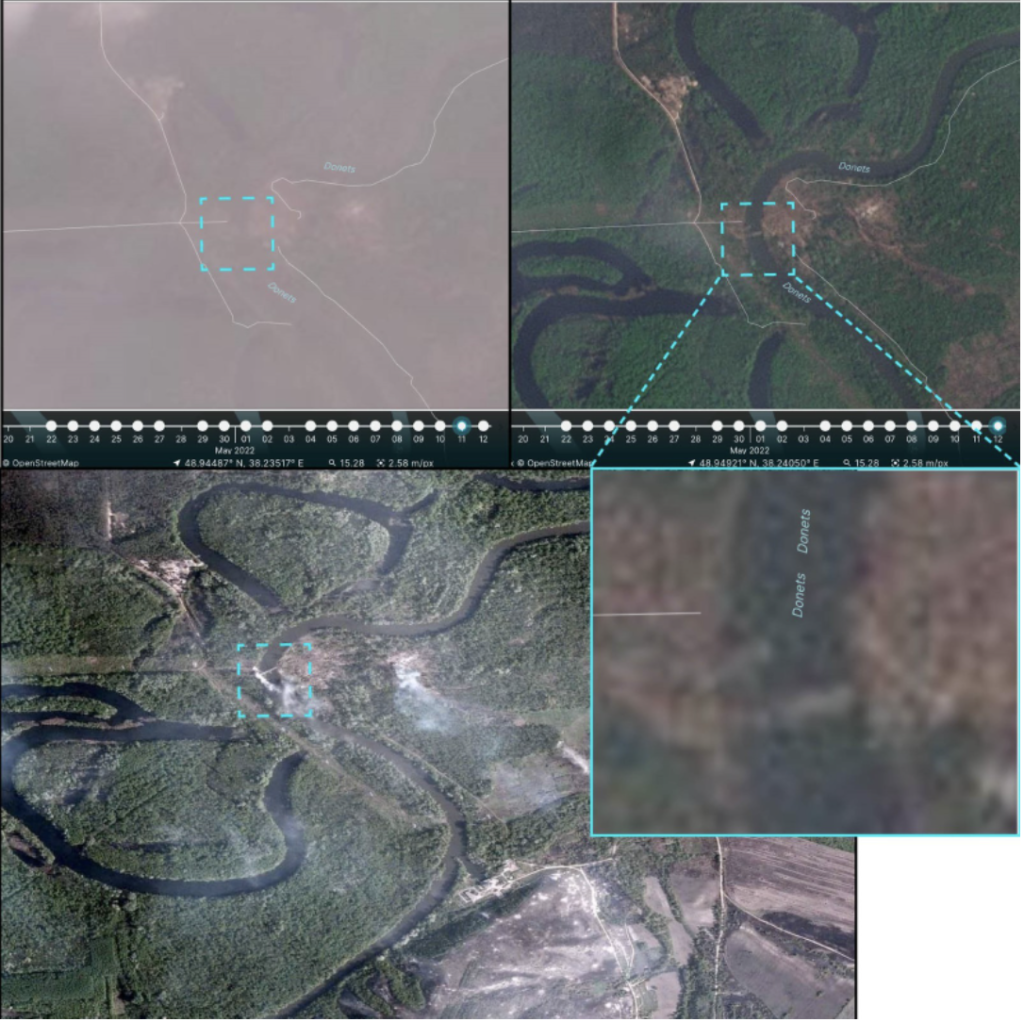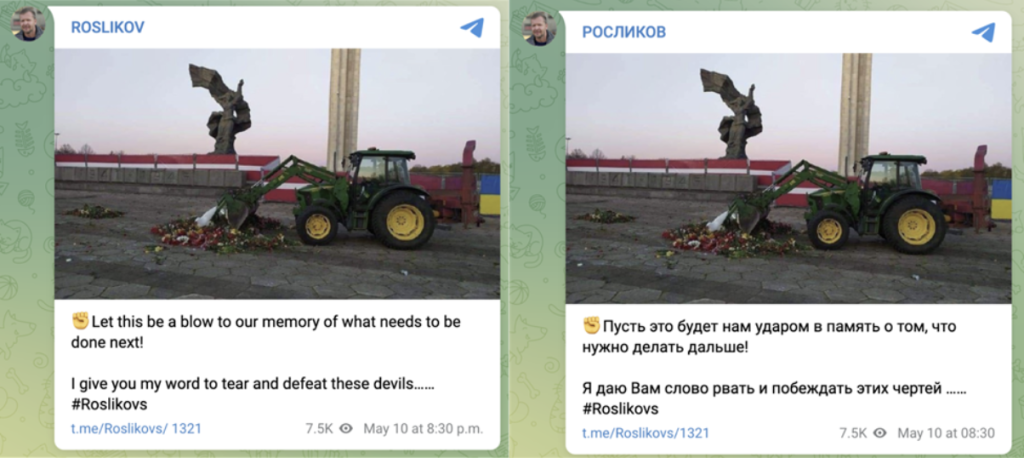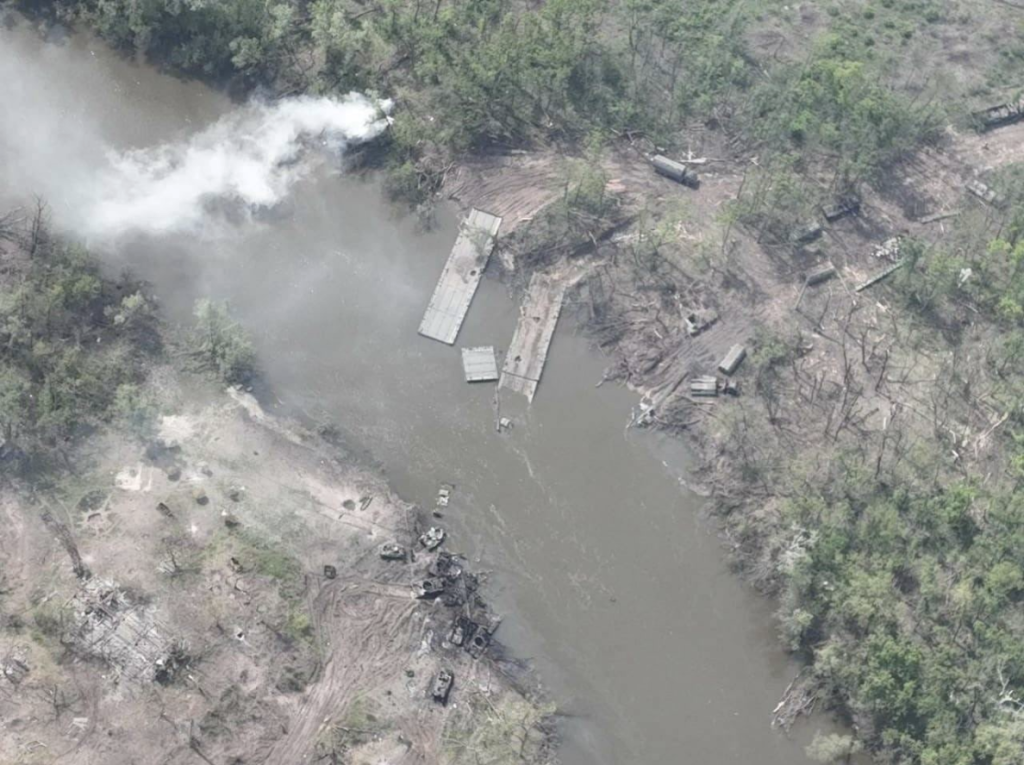As Russia continues its assault on Ukraine, the Atlantic Council’s Digital Forensic Research Lab (DFRLab) is keeping a close eye on Russia’s movements across the military, cyber, and information domains. With more than seven years of experience monitoring the situation in Ukraine, as well as Russia’s use of propaganda and disinformation to undermine the United States, NATO, and the European Union, the DFRLab’s global team presents the latest installment of the Russian War Report.
Security
Drone footage confirms failed Russian military pontoon crossing in Donbas
Tracking narratives
Pro-Kremlin sources misrepresent US actions to aid Ukraine
International reactions
Flower removal from Victory Day memorial in Latvia sparks political tensions
Drone footage confirms failed Russian military pontoon crossing in Donbas
On May 11, reports surfaced of Ukrainian forces successfully destroying a Russian unit trying to cross the strategically important river of Siversky Donets in the Donbas region. The reports were supported by drone photos showing the obliteration of the Russian units at their crossing point, which the DFRLab has geolocated to the river in question.
According to a tweet published by the Ukrainian Ministry of Defense, the Ukrainian Army artillerymen of the 17th Tank Brigade “have opened the holiday season” on Russian armed units. The Siverskyi Donets River, which flows from southern Russia through the separatist controlled regions of Donbas, has become a barrier for Russian forces trying to move deeper into Ukrainian territory. Some reports suggested that Russian units tried to cross the river five times, however this information could not be independently verified.
Drone footage of the incident allowed the scene to be easily geolocated to an area just a few miles from the Ukrainian town of Belohorivka, in Luhansk Oblast. The DFRLab then cross-referenced the drone footage with satellite imagery captured the day after the incident. For example, a Planet.com satellite image taken on May 12 shows the remains of the pontoon bridge (marked in blue). This confirmed the photos shared by Ukrainian Ministry of Defense as genuine.

According to one estimate, Ukrainian forces destroyed a Russian pontoon bridge together with at least six tanks, fourteen BMP armored vehicles, seven MT-LB amphibious vehicles, a tugboat and five other armored vehicles. A separate visual calculation done by open source researcher @Blue_Sauron, seventy-three pieces of Russian equipment were destroyed or abandoned. If accurate, this would constitute an entire battalion tactical group (BTG).
—Lukas Andriukaitis, Associate Director, Brussels, Belgium
Pro-Kremlin Telegram channels share forged letter claiming Poland intends to move troops into Ukraine
The Kremlin narrative that Poland plans to annex parts of western Ukraine continues to be spread by pro-Kremlin sources. The DFRLab previously reported on forged documents and fake billboards that were used to spread this narrative in an apparent attempt to drive a wedge between Poland and Ukraine.
The latest iteration of this narrative involves another forged letter, purportedly sent from the Ukrainian Armed Forces to Sergiy Deineko, chairman of the State Border Guard Service of Ukraine (SBGS). In the letter, the armed forces inform Deineko that the Polish Defense Ministry has authorized a Polish-Lithuanian peacekeeping contingent to be deployed into Ukrainian territory “with the purpose of ensuring the defense and security of the western part of our state.” The letter states that the peacekeeping contingent will combine four battalions comprised of 9,500 troops and 279 units. The so-called peacekeeping contingent is allegedly scheduled to enter Ukraine on May 22 at 4am through the Rava-Ruska border checkpoint. The forged letter requests the SBGS help facilitate the crossing.
SBGS debunked the letter, saying that there are no physical copies of such documents, as they are typically sent through an electronic system. SBGS confirmed that it did not receive the letter and said that the Ukrainian Armed Forces did not author the document. Additionally, the letter included multiple grammatical mistakes; for example, it said, “польско-украіінського” (Polish-Ukrainian) instead of “польсько-українського,” the proper way to write the phrase “Polish-Ukrainian.” Other grammatical errors in the letter suggest it may have been auto-translated using software rather than written by a native Ukrainian speaker.
Notably, pro-Kremlin sources also doubted the letter’s authenticity but chose to share it anyway. Multiple Russian Telegram channels forwarded the message. Conspiracy-leaning Twitter accounts also spread the letter.
—Roman Osadchuk, Research Associate
Pro-Kremlin sources misrepresent US actions to aid Ukraine
On May 9, US President Joe Biden signed into law a bill expediting the delivery of military aid to Ukraine. Two days later, the Russian Telegram channel Nezygar published a post stating that the primary beneficiaries of this law would be the “arms lobby and industry groups that sponsored Biden,” alongside “the UK, Israel, and the Swedish-Norwegian arms consortium.”
Nezygar also suggested that the arms industry is inflating prices by 30 percent. Without evidence, the channel asserted that the US has already invested “funds earned from the military budget” into liquefied natural gas (LNG) equipment and technologies “planned to be introduced in the ports of Romania and Bulgaria, after the complete partition of Ukraine.” The channel also shared a debunked claim that suggests Ukraine is selling a substantial number of weapons to countries in Africa and the Middle East.
Some pro-Kremlin channels amplified Nezygar’s post, but it received a second life after US Defense Secretary Lloyd Austin testified about the 2023 US defense budget before a House committee hearing. Austin stated that since the US does not have people on the ground in Ukraine, weapons accountability is of high priority. Pro-Kremlin media shared this story with misleading headlines such as “Secretary of Defense demands control over transferred ammunition.” Pro-Kremlin Telegram channels also amplified the articles.
Oleg Tsarev, a pro-Russian political figure, shared a post that falsely claimed Austin had said 15 to 20 percent of US weapons sent to Ukraine “instantly go to the countries of North, West and Central Africa.” He added that other Western weapons are sent to Syria, Iraq, Yemen and Myanmar. Tsarev’s post was amplified by other pro-Kremlin channels.
—Roman Osadchuk, Research Associate
Flower removal from Victory Day memorial in Latvia sparks political tensions
On May 9’s Victory Day holiday, Russians in Latvia gathered at the Victory Memorial in Riga to lay flowers and mark Russia’s defeat of Nazi Germany. The next morning, photos and a video surfaced online showing municipality workers in Riga using a tractor to remove the flowers, sparking outrage.
The Victory Memorial in Riga has been the site of Victory Day events since the early 2000s, when Russian President Vladimir Putin came to power. For many Latvians, however, the monument is a reminder of Soviet occupation and the “Russkiy Mir” ideology promoted by the Kremlin abroad.
In response to the removal of the flowers, Alexey Roslikov, a Latvian pro-Russian politician, published a post on Facebook and Telegram stating, “I give you my word to tear [apart] and defeat these devils,” suggesting violence against those who made the decision to remove the flowers. Roslikov later wrote that Facebook removed the post and restricted his account.

Other pro-Kremlin activists in Latvia, such as Vladimir Linderman, called for a “headquarters for the protection of the monument.” Saskana, a pro-Russian party that took a stance against Russia’s war in Ukraine, condemned decisionmakers in Riga and called the act a “provocation.” The Union of Latvian Russians, a pro-Kremlin political party, called for a protest on May 13 in Riga’s Old Town. The Russian embassy in Latvia also condemned the action.
News about the removal of the flowers was shared on pro-Kremlin Telegram channels, such as Mash, Shot, and Pul 3. Kremlin-controlled media outlets such as Zvezda, Rosiyskaya Gazeta, Sputnik Latvia, and Vesti.ru also shared the story. All of these outlets are blocked in Latvia, but are accessible to users employing VPN software.
In response to the flower removal, some residents returned to the monument on May 10 to leave more flowers. Pro-Russian political parties and pro-Kremlin NGOs published posts expressing solidarity with those leaving flowers. An impromptu public gathering also formed, with the crowd singing Soviet songs playing loudly from cars.
The Victory Memorial is controversial, as some Latvians see the monument as a symbol of Latvian occupation by the Soviet Union in 1945. As a result, some members of the public reported the gathering to the police. Though police were already present, a larger contingent of officers arrived and dispersed the crowd. Currently, the monument is barricaded by police.
The Kremlin-controlled TV channel Perviy Kanal reported on the May 10 protest and compared Latvian police officers to Nazis. In a statement Latvian State Police acknowledged, “In some cases force was used while detaining persons.”
The controversy raised political tensions across the country. There were calls for Latvian Interior Minister Maria Golubeva to resign, and police were criticized for what some people perceived as a slow response. Latvian State Police stated they have initiated an internal investigation.
There is currently a bill in Latvian Parliament that will allow for the demolishment of the Victory Memorial. Currently, the monument is protected by a bilateral Latvian-Russian agreement concerning the preservation of burial sites and monuments commemorating victims of World War II. The bill emerged after Russia invaded Ukraine.
On May 11, a crowdfunding campaign was launched to raise funds for the demolition of the monument. At the time of publishing, it had raised more than €220,000. Russian social media users in Latvia said the fundraising campaign was a scam, a provocation, and a waste of money.
—Nika Aleksejeva, Lead Researcher, Riga, Latvia
Image: Using drone footage supplied by the Ukrainian Defense Ministry, the DFRLab confirmed the incident took place near the Russian town of Belohorivka. ((Source: @DefenceU/archive)
